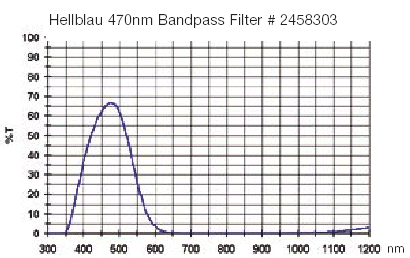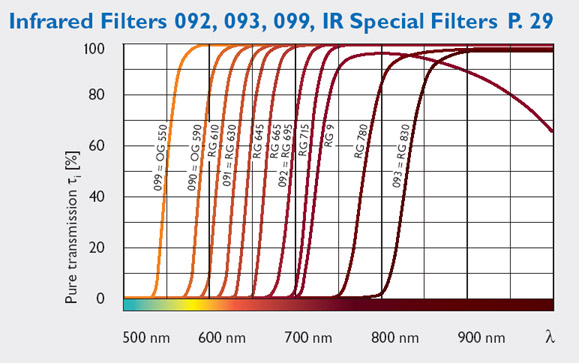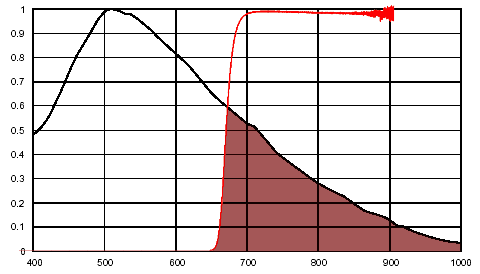Imaging Techniques
Webcam imaging with Philips ToUcam 740 Pro
Chapter 7- Bandpassfilters in planetary b/w imaging
Making the best out of a present seeing
A bandpass is a filter that lets only a finite frequency band with a certain band-width pass. For our application this is simply a color filter that lets only a limited band (usually one color for our eyes) of the light spectrum pass.


Example of baader light blue bandpass filter (435 nm)
During the mars opposition 2003 a technique called IR-LRGB gained reputation showing very detailed and contrasty mars images. This technique uses an infrared-passfilter to create a monochrome b/w image of mars and combines this with a regular color RGB image. It has been recognised that the near-IR captures show sharper and more contrasty details of the marsian surface than regular color shots, especially in below good seeing conditions. The IR capture will be used as the lightness channel of the combined image defining the lighness value of each pixel, the RGB color image defines only the color component of each pixel.
An IR-passfilter blocks the UV spectrum and (nearly) the
complete visual spectrum (called VIS in the following) depending on the
filter edge:

Transmission lines of various B+W (Schneider Kreuznach)
IR-passfilters - taken from B+W Filter Handbook
Other astro-imagers discovered that b/w lunar images captured through an IR-passfilter showed better sharpness than captures without a filter or with an UV/IR-cutfilter. This lead to an often heared conclusion:
Infrared light is less sensitive to seeing influences
Is this true and if so, why ?
The discoveries can be seperated into two parts:
- Bandpassfiltered captures and seeing
- Seeing vs. wavelengths
Bandpassfiltered captures and seeing
If we take a look at the combination IR-passfilter and CCD-camera we can see that we have an effective bandpassfilter: The rising edge of the band is provided by the filter and the falling edge by the spectral sensitivity limits of the CCD:

Spectral sensitivity of Sony ICX098BL b/w CCD
+

Transmission curve of Baader IR-passfilter measured by
André Knöfel
=

If we image in VIS with just an UV/IR-cutfilter in place with a black and white CCD various wavelength form the brightness value of a pixel. This has two major disadvantages:
- Atmospheric dispersion
- Dispersion by seeing
The atmosphere refracts different wavelength (read: colors) differently and the colors are shifted against each others in the image projected onto the CCD. By using a b/w CCD we have no possibility to correct this in a postprocessing step since all colors are blended into a single b/w image.
Seeing effects distort different wavelengths/colors differently. Blending all wavelengths into a single b/w image by the CCD causes unsharp image details by overlayed different distortions.
By using a bandpassfilter we limit the captured wavelengths to a small
band. Seeing distortions are quite unique inside the band, atmospheric
dispersion isn't visible.
-> A bandpass filter should be the first step in improving b/w captures
regardless of it's color.
When imaging in color (RGB) we can realign the color channels in image postprocessing to correct atmospheric dispersion. Color channels can be stacked and processed separately to use only the sharpest and less distorted frames of each color channel to correct seeing dispersion as far as possible.
Seeing vs. wavelengths
Which color should we choose for the bandpass filter ? At first we ignore the planetary object we want to capture, what wavelength is best in general ?
Assumption: Shorter wavelengths are more affected by seeing influences than longer wavelengths.
Known fact: Atmospheric refraction is wavelength
dependend, the shorter the wavelength, the greater the apparent shift.
See derivation here: http://ganymede.nmsu.edu/holtz/a535/ay535notes/node6.html
My daring assumption (without a proof yet ![]() )
is, that this fact can be applied to seeing distortions, also: The shorter
the wavelength, the higher the oscillation of the distortion. The assumption
seems to be proofed (well, at least supported) by reality.
)
is, that this fact can be applied to seeing distortions, also: The shorter
the wavelength, the higher the oscillation of the distortion. The assumption
seems to be proofed (well, at least supported) by reality.
This would lead to the conclusion to use the bandpass with the longest
wavelenth possible, in case of our ToUcams an IR-passfilter.
The usage of an IR-passfilter tends to "cost" a lot of light due to CCD sensitivity restrictions. A red bandpass should be the next best solution. The slight loss in sharpness due to more seeing influences should be compensated easily by the better signal to noise ratio possible by using fewer gain and/or shorter exposure times allowing to "freeze" seeing better.
The second criteria for choosing the filter color is the object to be captured:
Mars reflects infrared light from the sun quite well and the marsion surface shows good contrast in the near IR spectrum. IR or red is the color to choose.
The moon shows practically no color, it's monochrome (bright yellow/brown) and seems to reflect all VIS wavelengths + IR quite equally -> IR or red.
The gas giants reflect infrared light from the sun worse than mars does. Furthermore the surface of Jupiter and Saturn don't offer much detail-contrast in IR, Saturn's bands are much less defined than in VIS. The bandpass color should be chosen to receive the best surface detail rendering. Experiments with green and blue should be promising.
Venus shows nice cloud details in UV and is practically structureless in VIS and IR. A bandpass color despite UV should'n matter regarding surface details so IR or red should be right.
Now it's time to practically proof some theories. My first target for tests will be the moon captured through various bandpass filters, at last when the clouds will finally show some spaces :(